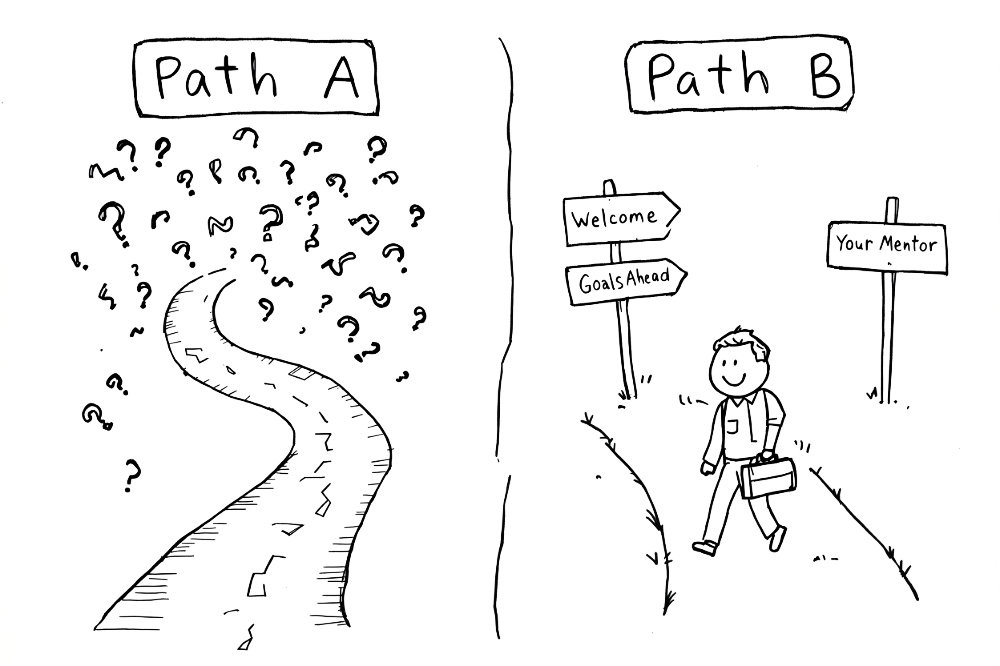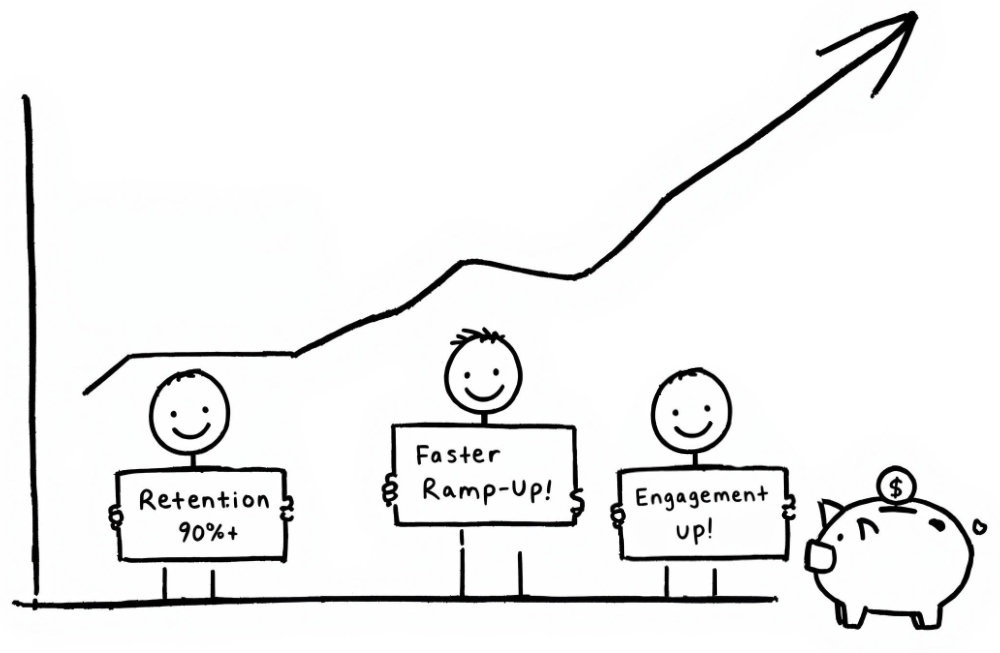It’s late afternoon, and two HR professionals—let’s call them The Skeptic and The Enthusiast—stand in a sunlit hallway just outside a conference room. One frowns at a stack of new-hire paperwork. The other smiles over a carefully prepared welcome package. They’re about to lock horns over the question: “Does a structured onboarding really matter?”
The stakes? Your first 90 days can determine whether a star hire becomes a long-term asset or a costly short-term fling.
If that doesn’t pique your interest, consider this: The first three months of employment can yield surprising returns—or catastrophic losses—depending on how well you guide new hires through their early journey. We’re talking hidden ROI, massive retention benefits, and a future workforce more engaged than your average rock concert crowd.
Skeptic: “I get it, onboarding is cute. But why spend time and money spoon-feeding new hires who should be self-starters anyway? If they can’t figure out the role in 90 days, are they really worth keeping?”
Enthusiast: “Hold up! The ‘sink-or-swim’ approach is as outdated as fax machines. The first 90 days set the tone for everything—engagement, productivity, culture fit. A sloppy start often leads to early exits and serious turnover costs.”
Skeptic: “Turnover costs? Sure, losing someone hurts, but aren’t employees disposable? We can just hire another one.”
Enthusiast: Laughs, shaking head “Ouch. Let’s talk ROI, buddy. Studies show structured onboarding can improve retention by over 50%. Imagine saving thousands by keeping your top talent engaged instead of recruiting replacements every few months.”
Skeptic: Sighs “Fine, but do we have proof it actually affects bottom-line performance?”
Enthusiast: “Absolutely. Engaged employees who hit the ground running contribute faster. I read somewhere that they’re productive 54% sooner, meaning less time to ramp up and more time delivering results. That’s money in the bank.”
The High-Stakes Gamble of the First 90 Days
Enthusiast: “Think about it, 90 days is not long. During that window, new hires form their perception of the company’s culture, leadership style, team dynamics, and expectations. If they feel lost or unsupported, guess what? They’re already sprucing up their LinkedIn.”
Skeptic: “So you’re saying the organization’s entire culture is judged by a newbie in a few weeks? Isn’t that dramatic?”
Enthusiast: “Not dramatic—just human nature. Early experiences leave lasting imprints. Unstructured onboarding is like inviting someone to a big family dinner but forgetting to give them a seat, a plate, or even introduce them. They’ll feel awkward, disconnected, and probably find reasons to leave the party early.”
Skeptic: “Okay, okay. So structured onboarding helps them feel welcome. Maybe that’s worth something.”
Welcoming equals loyalty equals ROI—see how the math works?
Enthusiast: “Bingo. A strong onboarding experience can boost employee retention by up to 82%. It’s not fluffy nonsense. It’s a strategic move. And the hidden ROI? Lower turnover, higher performance, better cultural fit, and a happier team overall.”
Culture, Engagement, and Anxiety
Skeptic: “Wait, you mentioned culture and engagement. How does onboarding impact that?”
Enthusiast: “Imagine you’re a new hire: You join a company that claims to value collaboration and transparency, but on Day 1 you’re handed a thick binder of outdated policies and left alone to figure out your role. Do you feel engaged? No. You feel misled. Structured onboarding, by contrast, integrates you into the culture, clarifies values, and introduces mentors. Engagement soars.”
Skeptic: “So it’s about reducing newbie anxiety?”
Enthusiast: “Exactly. Those first days can be nerve-wracking. A well-planned onboarding program provides clarity and support, making new hires confident in their abilities and understanding of the company mission. Confidence breeds better performance.”
A Little Illustration…

The mentor points out a clear path. That’s structured onboarding in action—turning chaos into clarity.
Enthusiast: “See that map? Without guidance, the first 90 days feel like a labyrinth. With structured onboarding, it’s a guided tour. And a guided tour leads to better ROI because people stay, perform, and recommend the company to others.”
The Role of Feedback and Continuous Improvement
Skeptic: “Okay, I’m warming up to this. Let’s assume we invest in onboarding. How do we know it’s working?”
Enthusiast: “Metrics, my friend. Engagement surveys, retention rates, performance benchmarks, and time-to-productivity all measure onboarding success. Check how quickly new hires hit their KPIs. Track how many stay beyond the first year. Survey their happiness.”
Skeptic: “So we must monitor and tweak the process?”
Enthusiast: “Yes, just like a good recipe. If the cake is dry, add more butter. If new hires say they’re lost, give them structured tasks, buddy systems, or an accessible knowledge base.”
Refining onboarding equals refining your workforce.
Skeptic: “This sounds like a lot of effort. Isn’t it too time-consuming?”
Enthusiast: “Short-term effort, long-term gain. Every hour spent welcoming new talent saves weeks of future headaches—like surprise resignations, morale dips, or rehiring costs. Trust me, you’ll thank yourself later.”
Hidden ROI: Beyond Productivity and Retention
Skeptic: “Let’s talk hidden ROI. We know retention improves, but what else is lurking there?”
Enthusiast: “How about a stronger employer brand? Great onboarding means your new employees become brand ambassadors. They’ll tell peers how welcoming and organized the company is. This attracts better candidates, reducing recruitment costs over time. Also, better onboarding leads to deeper cultural alignment, which fosters innovation and adaptability. Diverse teams that feel included often outperform rigid, homogenous teams.”
Skeptic: “Diversity and inclusion too? You’re pulling every lever here.”
Enthusiast: “Absolutely. Think long term. If your onboarding communicates that all backgrounds are valued and supported, you create a more inclusive environment. That environment generates resilience and creative problem-solving. Which translates into revenue growth, better products, and a healthier bottom line.”
Inclusion-driven onboarding = an innovation engine.
Onboarding Tech & Tools: Not Just a Boring Checklist
Skeptic: “I’m starting to see the light. But can we simplify? I don’t want to handle a million spreadsheets and forms.”
Enthusiast: “Welcome to the modern era. Tech solutions and ATS platforms like Machine Hiring can streamline onboarding tasks, track candidates, and ensure no one falls through the cracks. Modern systems parse resumes, manage candidate data, and set up structured processes that make onboarding frictionless.”
Skeptic: Smirks “You mean I don’t have to beg IT for login credentials every time?”
Enthusiast: “Exactly. Tools like Machine Hiring can integrate with your recruitment workflow to make handovers from hire to onboard seamless. Plus, they offer intelligent automation—like sending reminders, requesting data consents, and providing new hires with the resources they need. Less admin, more human interaction.”
Skeptic: “So I get to be more of a human leader and less of a paper-pusher?”
Enthusiast: “You got it. Automation frees you to focus on welcoming your new superstar instead of battling bureaucracy. And guess what? A smooth onboarding process signals professionalism and respect, reinforcing that the new hire made the right choice.”
A Quick Scenario: Who’s Leaving Early?
Enthusiast: “Think of two new hires, Alex and Jordan. Alex enters a company that treats Day 1 like a secret spy mission—no one explains anything, tools are locked behind red tape, and the team doesn’t bother saying hello. By Day 30, Alex updates their resume. By Day 60, Alex is gone. Ka-ching—turnover cost hits your budget.”
Skeptic: “Ouch, that sounds messy.”
Enthusiast: “Now Jordan joins a firm that sends a welcome email before the start date, maps out a 30-60-90 day plan, introduces team members, and sets clear goals. Jordan knows whom to ask for help, understands the KPIs, and feels encouraged. Jordan stays, grows, and within 6 months is outperforming targets. That’s the hidden ROI. Jordan’s productivity and loyalty pay dividends.”
Clarity, connection, and care = retained talent.
Skeptic: “You had me at no secret spy missions.”

Path A leads to confusion and an open exit door, Path B leads to a thriving garden of achievement. That’s the difference onboarding makes.
Common Objections and Smart Countermoves
Skeptic: “I can guess some pushback. ‘We don’t have time!’ or ‘We never did this before!’ How do we counter that?”
Enthusiast: “Remind them of the cost of not doing it. High turnover? Lost productivity? Damaged reputation? If time is tight, start small. Implement a basic welcome pack, a mentorship system, or short training videos. Gradually build a full program as you see results.”
Skeptic: “What if a team complains about the effort?”
Enthusiast: “Show them data. Link structured onboarding to faster ramp-up times and fewer interruptions later. When a new hire knows where to find info, they ask fewer basic questions. This frees existing staff to focus on their work instead of firefighting confusion.”
Onboarding is an investment, not an inconvenience.
The Psychological Edge: Confidence and Belonging
Skeptic: “You mentioned something about anxiety earlier. People get nervous starting new jobs. How does onboarding reduce that?”
Enthusiast: “By providing direction and reassurance. It’s human nature to feel uncertain in a new environment. Well-structured onboarding says, ‘You belong here, and we’ll help you succeed.’ This psychological safety fosters loyalty and reduces early attrition.”
Skeptic: “So, less panic, more performance?”
Enthusiast: “Exactly. Confident hires are more likely to take initiative, share ideas, and integrate into teams. This synergy improves overall morale. When people see newcomers well-supported, they trust leadership more. Trust leads to engagement, engagement to productivity, and productivity to profits. It’s a beautiful chain reaction.”
Remote and Hybrid Worlds: Onboarding Across Screens
Skeptic: “But what if we’re remote? How do I onboard someone I’ve never met in person?”
Enthusiast: “Video calls, virtual coffee chats, digital handbooks, and online Q&A sessions. The principles are the same: clarity, connection, and culture. Just delivered digitally. Make sure they have the right tech tools and know who to contact if they need help.”
Skeptic: “Sounds doable. Any fancy tools?”
Enthusiast: “Sure, platforms that integrate ATS features with communication tools. Some AI-driven systems can handle personal data consent, schedule training sessions, and send friendly reminders. It’s still onboarding—just adapted to the ‘Zoom age’. Don’t skimp on relationship-building, though. Even remotely, people crave human touch.”
Remote onboarding still demands human warmth.
Measuring Success: Metrics That Matter
Skeptic: “Let’s get more specific. What metrics should I track?”
Enthusiast: “Try these:
- Time-to-productivity: How quickly do newbies reach expected performance levels?
- Retention at 90 days and 1 year: Is there a downward trend in early exits?
- Engagement scores: Surveys on how included and supported they feel.
- Performance vs. Established KPIs: Are they hitting milestones sooner?
- Feedback loops: Are mentors and managers reporting smoother integration?
Each metric provides clues. Fine-tune your onboarding based on these insights.”
Skeptic: “It’s like a dashboard for new-hire happiness and productivity.”
Enthusiast: “Exactly. And guess what? As these metrics improve, so does your ROI.”

The hidden ROI: engaged employees, rising retention, and tangible savings all charted upwards.
A Win-Win for Everyone
Skeptic: “Alright, I’m sold. Onboarding isn’t just a warm-and-fuzzy HR ritual. It’s a strategic investment that pays off in saved costs, improved performance, stronger culture, and higher retention. Who knew those first 90 days carried so much weight?”
Enthusiast: “Welcome aboard the truth train! Now let’s spread the word. Use structured onboarding to elevate your workforce. Embrace tools that automate the drudgery. Keep refining with feedback and metrics. Your future self—and your bottom line—will thank you.”
Think long-term, invest in the first 90 days, and watch your hidden ROI emerge.
Skeptic: “I guess I’ll start prepping that welcome email now. Any template suggestions?”
Enthusiast: “Keep it simple: ‘Welcome to the team, here’s what to expect, and we’re here to help you succeed.’ Add a link to your org chart, maybe a video message from the CEO, and voilà—instant impact.”
And, oh, if you’re ready to simplify this whole process and make your hiring pipeline smooth as silk, consider trying out something like Machine Hiring. They even have a free trial, so you can see how technology can transform your onboarding from hot mess to best-in-class.
Ready to stop guessing and start building an onboarding experience that drives hidden ROI?
Request a free demo of Machine Hiring today.
Related Posts
- Stop Chasing Unicorns: How to Finally Improve Candidate Quality Metrics (and Actually Enjoy Hiring)
- What Is Predictive Analytics in Recruitment & How Can It Help?
- Effective Talent Acquisition Methods That Shatter Old Norms
- Recruitment Trends for 2025: Are You Prepared?
- Mind-Blowing Ways AI Is Transforming Recruitment


